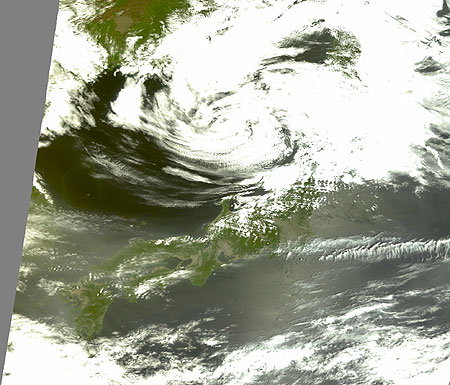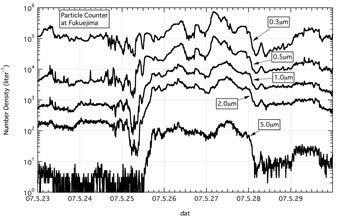Seen from Space 2007
Asian Dust Covers Japan on May 26 and 27, 2007
| |
 |
| Fig. 1 Asian Dust over western Japan |
On May 26 and 27, Asian Dust ("KOSA," meaning "Yellow Sand" or "Yellow Dust" in Japanese) was observed over all of Japan. Both Asian Dust and photochemical smog became problems this year. Figure 1 depicts Japan as observed by MODIS on board the NASA Earth-observing satellite (Terra) on May 27. The aerosol can be seen extending completely from Western to Eastern Japan. Asian Dust usually looks brown, but there is a very thin, whiter part of the cloud this time, which was determined to be derived from human activity. However, this does not clearly indicate that the aerosol is photochemical smog derived from factories and auto exhaust because there is much smoke from agricultural burning this season.
 |
Fig. 2 Particle Count of Aerosol as Observed in Goto Islands*
|
Figure 2 depicts the particle count of aerosol as observed on Fukue Island in the Goto Island group. Asian Dust has a high proportion of particles exceeding 5µm. The graph of 5µm particles in Fig. 2 indicates that there are some particles by May 25. However, the number of particles started to increase in the afternoon, and over 100 particles per liter were continuously observed from May 26 to 27. The number of particles then decreased on May 28. This is not an especially large number, but Asian Dust has continued for a long time.
* The vertical axis indicates particles per liter. The logarithmic scale represents 100=1 particle, 103=thousand particles, 106=million particles. The particle diameters are 0.3, 0.5, 1.0, 2.0 and 5.0µm beginning from the top.
The observation on Fukue Island is provided by SKYNET; the observation site is maintained by the Research Institute for Humanity and Nature, and Chiba University. This data is courtesy of SKYNET.
 SKYNET SKYNET
|
Explanation of the images:
| Satellite: |
EOS-Terra (NASA) |
| Sensor: |
Moderate Resolution Imaging Spectro-radiometer (MODIS; NASA) |
| Date: |
May 27, 2007 |
| Resolution: |
500m |
|
 |
|